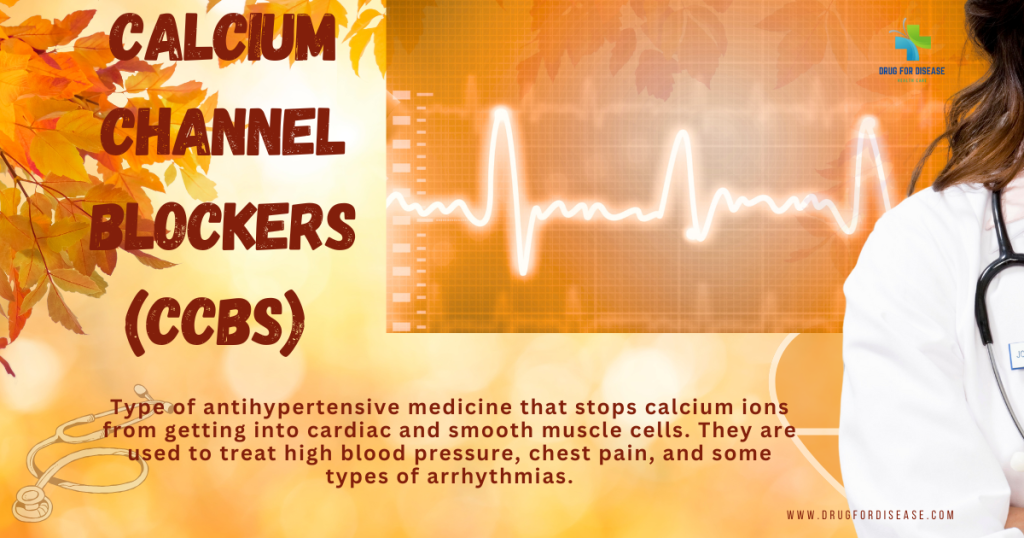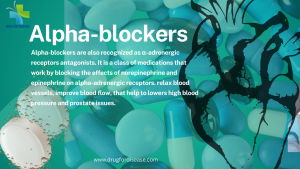Calcium Channel Blockers (CCBs)

Calcium channel blockers are a type of antihypertensive medicine that stops calcium ions from getting into cardiac and smooth muscle cells. This causes blood vessels to widen, the heart rhythm to slow down, and blood pressure to drop. They are often used to treat high blood pressure, chest pain, and some types of arrhythmias. Calcium channel blockers (CCBs) work especially well to make large blood vessels less stiff. This stiffness is a typical cause of high systolic blood pressure in older people. Calcium channel blockers became quite popular in the 1960s. This group of drugs was discovered in the lab of German pharmacologist Albrecht Fleckenstein in 1964. Classification of Calcium channel blockers They are of two types, known as dihydropyridines and non-dihydropyridines. Dihydropyridines Mainly it causes vasodilation, decreases Blood Pressure, may cause reflex tachycardia. This CCB class can be easily recognized by the suffix -dipine .Examples include Amlodipine, Nifedipine, Felodipine, Nimodipine etc. Non-Dihydropyridines; its primary action is cardiac depression, decreases heart rate & contractility, produce anti-arrhythmic effect. Examples include Verapamil, Diltiazem Mechanism of Action Calcium channel blockers stop L-type voltage-gated calcium channels from working in the smooth muscle of blood vessels, heart muscle cells, and nodal tissue. Vascular Action: Stops calcium from getting into smooth muscle in arteries, which causes vasodilation, which lowers systemic vascular resistance and blood pressure. Cardiac Action (non-Dihydropyridines): Lower calcium entrance into SA and AV nodes, which slows conduction, lowers heart rate, and lowers myocardial contractility. Therapeutic Uses The FDA has approved different uses for each medicine of Calcium channel blockers. These medicines are commonly prescribed for the treatment of Hypertension (especially in elderly and Black patients) Arrhythmias. supraventricular tachycardias used to regulate / manage cardiac beats (Verapamil/Diltiazem) Angina Pectoris treat chest pain due to angina pectoris Raynaud’s phenomenon Hypertrophic cardiomyopathy (a disease in which the heart muscle gets thickened) Migraine prophylaxis (off-label) Adverse effects. Dihydropyridines. cough Peripheral edema (Swelling in the legs and feet) Headache, flushing, fatigue, heartburn Reflex tachycardia Hypotension can worse proteinuria in neuropathic patients Non-Dihydropyridines Bradycardia Constipation (especially due to verapamil) AV block Worsening heart failure Drug interactions Calcium channel blockers including Dihydropyridines & Non dihydropyridines are metabolized in liver through cytochrome P450 enzyme system, making them prone to several clinically significant drug interactions. Some common & general drug interactions are as follow Beta-blockers – CCBs (esp. with non-DHPs) may lead to additive cardiac depression. Concomitant administration will increase the risk of bradycardia, hypotension & heart block. better to use some other antihypertensive or monitor closely. Digoxin-CCBs (with verapamil/diltiazem) Inhibits renal clearance of digoxin. It increases digoxin toxicity that can be characterized by nausea, arrhythmias etc. need to monitor serum levels. CYP3A4 inducers (e.g., rifampin, phenytoin, carbamazepine)-CCBs when given together lead to increased metabolism of CCBs, decrease the efficacy of CCBs. Consider dose increase or use alternate. Statins -CCBs (esp. simvastatin with amlodipine/verapamil), inhibits metabolism of statins that increase the risk of myopathy. it is better to limit the simvastatin dose to ≤20 mg/day with amlodipine Antiarrhythmics (e.g., amiodarone) -CCBs synergies the effects on AV conduction & increases risk of AV block, bradycardia. Monitor ECG and symptoms. Lithium & CCBs, reduce the clearance of lithium, may lead to lithium toxicity. When to administer with caution Hepatic impairment: Patients with hepatic impairment typically need to have their doses changed because these medicines are broken down in the liver. So, it is best to look up the information on the individual agent in the package insert or other trustworthy sources. Renal impairment: Most of the time, patients with renal impairment don’t need to change their dose. But better to get guidance from doctors should check the renal dose. Pregnant women: Limited data from human research indicate that fetal damage is generally not anticipated with either class of calcium channel blockers (CCBs). When administering CCBs on pregnant women, doctors should think about the risks and benefits. Breastfeeding women: There is not enough data from human research to say that either class of CCBs would hurt babies. However, there is no data to determine how these medications affect milk production. Older patients: CCBs are excreted more slowly in senior individuals, therefore be careful with those who have liver problems. Conclusion Calcium channel blockers are essential agents in the management of hypertension, particularly in elderly patients and those with specific comorbidities such as angina or arrhythmias. Due to their favorable safety profile and robust outcome data, these agents remain the preferred choice for first-line treatment, frequently utilized in combination regimens to achieve optimal control. FAQ 1. What are calcium channel blockers and what is their mechanism of action? Calcium channel blockers are medications that reduces muscle contraction, vasodilation, lower blood pressure and in some cases heart rate also by blocking L-type calcium channels in heart and blood vessels. 2. What conditions are calcium channel blockers used to treat? Hypertension (especially in elderly and Black patients), Arrhythmias. supraventricular tachycardias used to regulate / manage cardiac beats (Verapamil/Diltiazem), Angina Pectoris treat chest pain due to angina pectoris, Raynaud’s phenomenon, Hypertrophic cardiomyopathy (a disease in which the heart muscle gets thickened) & Migraine prophylaxis (off-label) 3. What are the common side effects of calcium channel blockers? Peripheral edema (Swelling in the legs and feet), Headache, flushing, Reflex tachycardia, Hypotension, Bradycardia, Constipation (especially due to verapamil), AV block etc..

